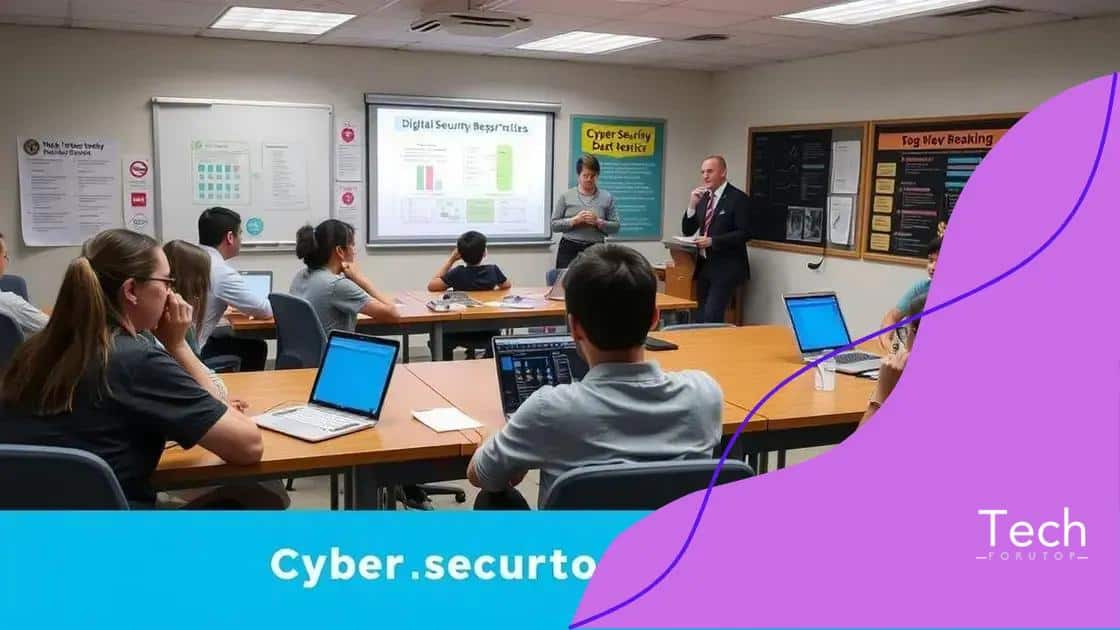Student digital security initiatives: protecting online identities

Engaging students in digital security awareness through interactive workshops, technology integration, and peer education empowers them to protect their online identities and fosters a culture of safety in schools.
Student digital security initiatives are increasingly vital in today’s digital age. With online threats looming, it’s crucial for students to understand how to protect themselves. How can schools foster a culture of safety? Let’s explore.
Understanding digital security for students
Understanding digital security for students is essential in today’s technology-driven world. As students engage more with online platforms, they face various risks that can threaten their personal information and security.
What is Digital Security?
Digital security refers to the protection of electronic data from unauthorized access or attacks. This includes safeguarding sensitive information like passwords, social security numbers, and academic records. With the rise of internet usage among students, understanding digital security becomes crucial for maintaining safety.
Common Threats Students Face
Students encounter multiple threats in the digital realm. Here are a few:
- Phishing: This involves deceptive emails or messages that trick users into revealing personal information.
- Malware: Malicious software can infect devices and steal information.
- Cyberbullying: Online harassment can affect students’ mental health and safety.
Recognizing these threats is the first step toward creating a safer online environment. Schools and students must work together to implement preventive measures.
Why Digital Security Matters
As students navigate through their academic and social activities online, being aware of digital security helps them protect their identities and privacy. A lack of security can lead to serious consequences, such as identity theft or exposure to inappropriate content. Every student should feel safe while using technology for their studies and social interactions.
Moreover, understanding digital security empowers students to take control of their online presence. They can make informed choices about what to share and whom to trust online, fostering a culture of responsibility.
Key threats to student online safety
Students face numerous challenges in maintaining their online safety. Understanding these key threats is vital for protecting personal information and mental well-being.
Common Online Threats
One of the biggest challenges students encounter is cyberbullying. This form of harassment can happen on social media, text messages, or online gaming. It can cause emotional distress and negatively affect a student’s mental health.
Social Engineering
Social engineering is another significant risk. Attackers use manipulation to trick students into revealing sensitive information, like passwords or personal data.
- Phishing scam: Fake emails or messages that appear legitimate encourage students to click on links or share details.
- Pretexting: An attacker poses as someone familiar to gain information, often using personal details they’ve found online.
- Baiting: Offers or promotions lure students into downloading harmful software.
Understanding how these threats work can equip students with the knowledge to respond appropriately and protect themselves.
Data Privacy Issues
Another concern is the lack of data privacy. Many students unknowingly share personal information online, exposing themselves to risks. This information can be used for identity theft or harassment.
It’s important for students to regularly review privacy settings on their social media accounts and be mindful of the information they share. Using strong, unique passwords for different accounts is also crucial for maintaining security.
Effective digital security initiatives in schools

Implementing effective digital security initiatives in schools is crucial to safeguard students and staff from online threats. These initiatives not only protect sensitive information but also create a safer online learning environment.
Training and Awareness Programs
One vital component is providing training and awareness programs for both students and educators. Workshops can help everyone understand the basics of digital security, including how to recognize threats.
- Identifying phishing attempts: Teaching students to spot suspicious emails or messages can prevent data breaches.
- Safe internet practices: Encouraging safe browsing habits reduces the risks associated with online research.
- Report mechanisms: Establishing clear channels for reporting security issues fosters prompt responses.
When schools offer these programs, they empower students to take charge of their online safety and become advocates for others.
Implementing Security Technologies
Utilizing security technologies is another critical step. Schools should invest in software that protects against malware and data breaches. Strong cybersecurity measures include:
- Firewalls: These act as barriers to prevent unauthorized access to the school’s network.
- Antivirus software: Regularly updated software helps detect and eliminate threats.
- Encryption: Protecting sensitive data through encryption ensures that information remains secure, even if intercepted.
By implementing these technologies, schools can minimize vulnerabilities and protect the integrity of their systems.
Fostering a Culture of Security
Creating a culture of security within the school is essential. This involves establishing policies that prioritize digital safety and encouraging collaboration among students, teachers, and parents. Regular security drills can simulate scenarios where a breach occurs, teaching everyone how to respond effectively.
Additionally, involving parents in the conversation about digital security reinforces the importance of safe practices at home. Schools can hold informational sessions to share resources and strategies for maintaining security at home, creating a unified front against threats.
Tools and practices for enhancing security
Utilizing effective tools and practices is essential for enhancing security in schools. These strategies not only protect students but also ensure that the integrity of educational systems is maintained.
Essential Security Tools
First and foremost, schools should implement various security tools that cater to their specific needs. Some of the most effective tools include:
- Firewalls: These act as barriers, preventing unauthorized access to the school’s network and protecting sensitive data.
- Antivirus and anti-malware software: Regularly updated software helps detect and remove threats before they can cause harm.
- Network monitoring tools: These tools keep track of all activities within the network, allowing schools to identify suspicious behavior quickly.
Using these tools collectively provides a robust defense against cyber threats.
Best Practices for Digital Security
Beyond tools, implementing best practices is crucial in fostering a culture of security. Educating students and staff about these practices ensures everyone plays a part in maintaining safety. This can include:
- Regular password updates: Encourage changing passwords at least every three months to prevent unauthorized access.
- Two-factor authentication: Implementing this adds an extra layer of security for online accounts.
- Data encryption: Encrypting sensitive data ensures that even if data is intercepted, it remains unreadable.
By adhering to these best practices, schools can significantly reduce the risk of security breaches.
Moreover, encouraging open communication about security concerns creates an environment where students and staff feel empowered to discuss and identify potential threats. Regularly scheduled training sessions keep security top of mind and can make a real difference in preventing incidents.
Engaging students in digital security awareness
Engaging students in digital security awareness is crucial for building a safe online environment. When students understand the importance of protecting their personal information, they are more likely to adopt safe practices.
Interactive Workshops
One effective way to foster this awareness is through interactive workshops. These sessions can include:
- Hands-on activities: Allowing students to participate in real-life scenarios teaches them about different threats.
- Role-playing games: Students can act out situations involving cyberbullying or phishing attempts, which makes the learning experience engaging.
- Guest speakers: Inviting cybersecurity experts to share their knowledge increases interest and awareness.
Such workshops not only inform students but also empower them to communicate about digital security topics.
Incorporating Technology
In addition to workshops, utilizing technology can enhance engagement. Schools can create online platforms or apps that provide resources on digital security. Students could benefit from:
- Quizzes and games: Interactive quizzes can test their knowledge and keep learning fun.
- Discussion forums: Platforms where students can discuss their experiences with digital security issues promote collaborative learning.
- Video tutorials: Short, engaging videos can explain complex security concepts in an easy-to-understand format.
By integrating these technological tools, schools can make learning about security more accessible and enjoyable.
Promoting Peer Education
Another impactful strategy is to encourage peer education. Students can be trained to lead discussions or presentations on digital security issues. By involving students in teaching their peers, schools create a sense of responsibility and community.
Additionally, creating clubs focused on digital security can help foster ongoing interest and awareness. These clubs can organize events, workshops, and campaigns, all aimed at enhancing the school’s overall security culture.
In conclusion, engaging students in digital security awareness is essential to create a safe online environment. By implementing interactive workshops, utilizing technology, and promoting peer education, schools can foster a culture of security. These initiatives help students understand the importance of protecting their personal information and empower them to take proactive steps against online threats. Ultimately, the goal is to ensure that every student feels safe and confident while navigating the digital landscape.
FAQ – Frequently Asked Questions about Engaging Students in Digital Security Awareness
Why is it important to engage students in digital security awareness?
Engaging students in digital security awareness helps them understand online risks and empowers them to protect their personal information.
What types of activities can be used to raise awareness?
Interactive workshops, role-playing games, and discussions with cybersecurity experts are effective activities to raise awareness among students.
How can technology enhance digital security education?
Technology can provide quizzes, games, and online platforms that make learning about digital security fun and engaging.
What role does peer education play in digital security?
Peer education encourages students to teach one another, fostering a collective responsibility for maintaining a secure digital environment.





